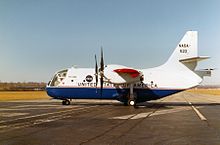Ling-Temco-Vought XC-142
| Ling-Temco-Vought (LTV) XC-142 | |
|---|---|
 The only surviving XC-142A |
|
| Type: | Experimental VTOL transport aircraft |
| Design country: | |
| Manufacturer: |
|
| First flight: |
September 29, 1964 |
| Commissioning: |
Flight tests ended in 1970 |
| Production time: |
1964 to 1966 |
| Number of pieces: |
5 |
The Ling-Temco-Vought (LTV) XC-142 was built in the 1960's American V / STOL - convertible aircraft with bottom hung windows . Although the prototypes were among the most successful high-flyers of the time, there was no series production.
The XC-142 was developed by Vought Aeronautics together with Hiller Aircraft and Ryan Aeronautical and is therefore also known as the Vought-Hiller-Ryan XC-142 . However , this type is registered with the Federal Aviation Administration as Ling-Temco-Vought XC-142 (FAA code 5210808).
history
In 1959 Princeton University published a study for the US Department of Defense on requirements for future VTOL or V / STOL aircraft, based on data from previous test series. Based on this study, the three largest branches of the US military ( Army , Navy and Air Force ) jointly tendered the development and construction of a vertical take-off and landing combat zone transporter as part of the Tri-Service Assault Transport Program in 1961 . In September 1961, the concept of Vought Aeronautics (part of Ling-Temco-Vought) was the winner of the tender. The Hiller Aircraft Corporation , which a few years earlier, the similar X-18 was designed, and the Ryan Aeronautical Company were also responsible for planning and production of the machines.
The first of five prototypes had its rollout at the beginning of 1964, the first level flight took place on September 29, 1964. This XC-142A completed its first hover on December 29, 1964, the transition to level flight ( Transition ) succeeded on January 11, 1965. After these first test flights at Vought, the XC-142A flew 1900 km from Dallas to Edwards Air Force Base and officially handed it over to a team of 150 civilian and military testers ("Tri-Service Test Force") on July 9, 1965.
Weaknesses in the drive shafts and gears became noticeable in early tests. As a result of technical weaknesses and pilot errors, each of the five XC-142s was involved in at least one accident with severe damage. The worst accident occurred on a test flight from Vought near Dallas in May 1967. During a simulated rescue operation, the steering propeller failed and the machine crashed into a wooded area. Three crew members were killed.
Nevertheless, the machines were able to perform numerous maneuvers, including search and rescue simulations, missions on aircraft carriers and airborne operations. But after moderate results of a series of tests by the military ("Category II Operational Suitability Program"), which was carried out from July to August 1967 and comprised 113 flights, the program was discontinued. The only remaining machine was given to NASA for further testing. By this time, 39 pilots had completed a total of around 420 hours on the XC-142. The XC-142 was the largest VTOL aircraft to ever land and take off on an aircraft carrier.
In 1970, NASA also finished its tests and handed the machine over to the National Museum of the United States Air Force . The Vought designers already had plans for further development with more powerful T64-GE-S4A engines and a modified fuselage. However, when the military ended the test series, the project was also discontinued at Vought.
successor
Building on the equally unsuccessful experience with the Bell XV-3 tilt rotor aircraft, the Bell company built the "Model 301" at the end of the 1960s, which completed its first hover on May 3, 1977, and derived from it the XV-15 . From this, Bell and Boeing developed the V-22 "Osprey" , which is now in service with the United States Marine Corps.
technology
The XC-142 had the fuselage of a medium-weight transport aircraft and could carry up to 32 fully equipped soldiers. In the stern there was a loading ramp that made the aircraft passable for light vehicles.
The four engines were mounted in the tilting wings ( swivel range : 100 °) and connected to one another by a shaft system, so that only one engine was sufficient to set all propellers in rotation. However, at least two engines were necessary for level flight. The control in the hover was a pitch of GfK -Hauptpropeller, supported by the in the air flow control surfaces , accomplished. In addition, the XC-142 had a horizontal propeller at the stern, with which the pitch control was made easier. An electronic system ensured that all control surfaces were permanently compensated for, as well as the control of the engines and simulated resistance forces on the control elements (a kind of " force feedback "). In an emergency, the electronic aids could be bypassed by the pilots.
Technical specifications

| Parameter | Data |
|---|---|
| crew | 2-3 |
| Passengers | 32 |
| length | 17.71 m |
| span | 20.57 m |
| height | 7.82 m |
| payload |
|
| Max. Takeoff mass | 16,998 kg |
| Cruising speed | 483 km / h |
| Top speed | 692 km / h at an altitude of 6100 m |
| Service ceiling | 8520 m |
| Range |
|
| Engines | four General Electric T64 -GE-1 turboprops with 2125 kW each |
literature
- Encyclopedia of Airplanes. Weltbild Verlag, Augsburg 1995, ISBN 3-89350-055-3 .
Web links
- XC-142A. In: Products. Vought Aircraft Industries, Inc., archived from the original on March 16, 2007 ; accessed on February 5, 2018 (English, manufacturer's homepage).
Individual evidence
- ↑ database of the Federal Aviation Administration (download required)
